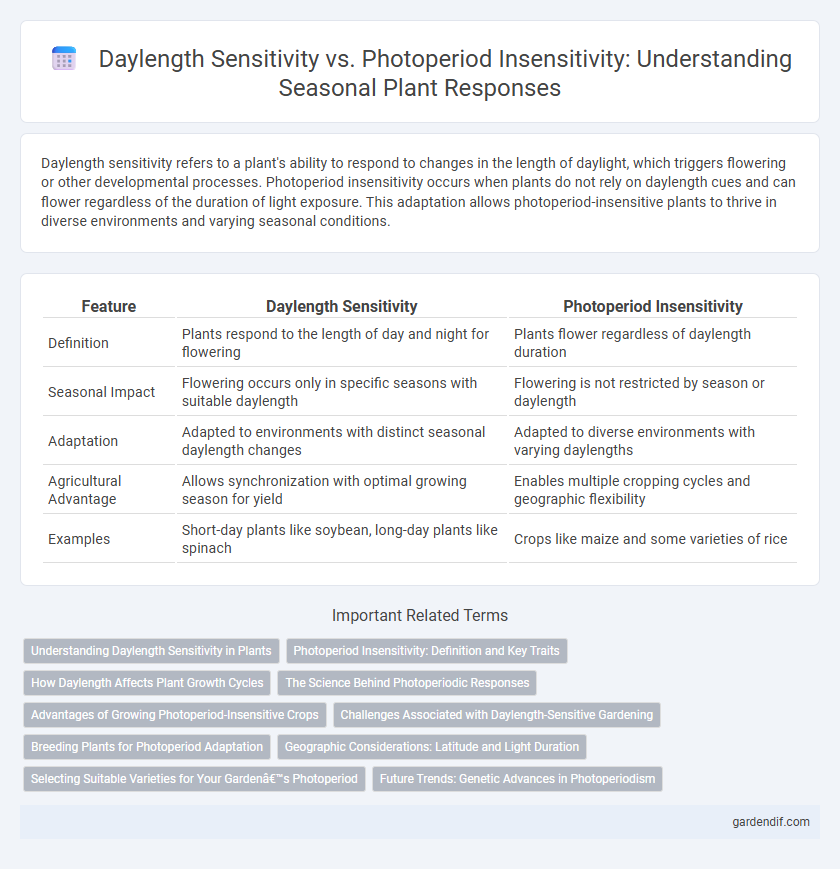
Daylength sensitivity vs Photoperiod insensitivity Illustration
Daylength sensitivity refers to a plant's ability to respond to changes in the length of daylight, which triggers flowering or other developmental processes. Photoperiod insensitivity occurs when plants do not rely on daylength cues and can flower regardless of the duration of light exposure. This adaptation allows photoperiod-insensitive plants to thrive in diverse environments and varying seasonal conditions.
Table of Comparison
| Feature | Daylength Sensitivity | Photoperiod Insensitivity |
|---|---|---|
| Definition | Plants respond to the length of day and night for flowering | Plants flower regardless of daylength duration |
| Seasonal Impact | Flowering occurs only in specific seasons with suitable daylength | Flowering is not restricted by season or daylength |
| Adaptation | Adapted to environments with distinct seasonal daylength changes | Adapted to diverse environments with varying daylengths |
| Agricultural Advantage | Allows synchronization with optimal growing season for yield | Enables multiple cropping cycles and geographic flexibility |
| Examples | Short-day plants like soybean, long-day plants like spinach | Crops like maize and some varieties of rice |
Understanding Daylength Sensitivity in Plants
Daylength sensitivity in plants determines their flowering time based on the length of daylight, classified as short-day, long-day, or day-neutral plants. Photoperiod-sensitive species rely on specific light durations to trigger developmental processes, optimizing reproduction to seasonal changes. Understanding this mechanism enhances crop management, enabling breeders to select varieties suited for varying climatic regions and improving yield stability.
Photoperiod Insensitivity: Definition and Key Traits
Photoperiod insensitivity refers to a plant's ability to flower regardless of daylength, enabling growth across diverse geographic regions and seasons. Key traits include genetic adaptation that bypasses the need for specific light cues, resulting in more flexible and predictable flowering times. This trait is crucial for crop breeding programs aimed at improving yield stability under variable environmental conditions.
How Daylength Affects Plant Growth Cycles
Daylength sensitivity determines how plants respond to varying durations of daylight, directly influencing their flowering and growth cycles. Photoperiod-sensitive plants require specific lengths of day or night to trigger developmental phases, ensuring synchronization with seasonal changes. In contrast, photoperiod-insensitive plants grow and bloom regardless of daylength, allowing adaptation across diverse environments and planting schedules.
The Science Behind Photoperiodic Responses
Photoperiodic responses in plants determine flowering based on daylength sensitivity, which is regulated by internal circadian rhythms and photoreceptors like phytochromes and cryptochromes. Daylength-sensitive plants require a specific duration of light or darkness to trigger flowering, while photoperiod-insensitive plants flower regardless of daylength due to genetic variations affecting light signal pathways. Understanding these molecular mechanisms enables optimization of crop yields by manipulating planting schedules and light exposure conditions in controlled environments.
Advantages of Growing Photoperiod-Insensitive Crops
Photoperiod-insensitive crops offer the advantage of flexible planting schedules, as they do not rely on specific daylengths to initiate flowering or fruiting. This trait enhances adaptability across diverse geographic regions and varying seasonal conditions, enabling multiple cropping cycles within a year. Consequently, farmers achieve higher yield stability and improved resource utilization regardless of natural photoperiod fluctuations.
Challenges Associated with Daylength-Sensitive Gardening
Daylength-sensitive plants rely on specific photoperiods to trigger flowering and growth phases, creating challenges in regions with varying or unpredictable daylengths. Gardeners must carefully select species suited to local photoperiod patterns to avoid poor crop yields and delayed maturation. Photoperiod insensitivity offers greater flexibility, but daylength sensitivity demands precise timing and location-specific cultivation knowledge to optimize plant development.
Breeding Plants for Photoperiod Adaptation
Breeding plants for photoperiod adaptation enhances crop yield by selecting varieties with desired daylength sensitivity or photoperiod insensitivity traits. Photoperiod-sensitive plants adjust flowering time based on daylength, enabling synchronization with optimal seasonal conditions, while photoperiod-insensitive plants flower regardless of daylength, improving adaptability to diverse environments. Incorporating genetic markers linked to photoperiod response facilitates precision breeding, accelerating development of cultivars suited for specific latitudes and changing climate patterns.
Geographic Considerations: Latitude and Light Duration
Daylength sensitivity, or photoperiodism, in plants varies significantly with geographic latitude, as higher latitudes experience longer summer days and shorter winter days, influencing flowering and growth cycles. Photoperiod-sensitive species rely on specific light durations to trigger developmental processes, making their cultivation more challenging near the poles where daylight extremes occur. In contrast, photoperiod-insensitive plants exhibit adaptability across diverse latitudes by flowering independently of daylength, enabling broader agricultural applications in varying light conditions.
Selecting Suitable Varieties for Your Garden’s Photoperiod
Selecting suitable varieties for your garden's photoperiod involves understanding daylength sensitivity, which affects flowering based on the duration of light exposure. Photoperiod-sensitive plants require specific daylengths to initiate growth stages, while photoperiod-insensitive varieties thrive regardless of daylength, offering greater flexibility in diverse climates. Choosing photoperiod-insensitive varieties ensures consistent yields across varying seasonal light conditions, making them ideal for gardens with unpredictable or shifting photoperiods.
Future Trends: Genetic Advances in Photoperiodism
Genetic advances are unlocking new pathways to modify daylength sensitivity in crops, enabling precise control over photoperiodic responses to improve yield and adaptability. CRISPR and gene editing technologies target key photoreceptor genes like CONSTANS and PHYTOCHROME to engineer photoperiod insensitivity, allowing plants to flower independent of traditional daylength cues. Future trends emphasize integrating genomic selection with phenotypic data to accelerate breeding of varieties optimized for changing climates and diverse growing regions.
Daylength sensitivity vs Photoperiod insensitivity Infographic

 gardendif.com
gardendif.com